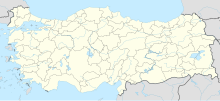Samosata
Coordinates: 37 ° 33 ' N , 38 ° 30' E
Samosata ( ancient Greek Σαμόσατα ) was an ancient city, the ruins of which are now flooded by the Ataturk reservoir near the modern Turkish city of Samsat in the Adıyaman province . Located in the southeast of today's Turkey on the right bank of the Upper Euphrates, it was attached to an east-west trade route to protect an important river crossing. Samosata was also a stop on the route from Damascus , Palmyra and Sura up to Armenia and the Black Sea . Finds from Samosata are exhibited in the Archaeological Museum of Adıyaman , including the Samsat 1 stele .
history
The place was named Kummuhu of the Hittites founded and was the capital of the province Kummuh of the Assyrian empire . Around 160 BC In BC Samosata became the capital of the Hellenistic Kingdom of Commagene . It got its name from the Commagenic ruler Samos II. In 72 AD, Samosata was conquered by the Roman Empire and formally integrated into the empire together with the entire Kommagene. The city was an important trading center due to its Euphrates crossing and became a local center for Greek-Hellenistic education. The most famous son of Samosata was the writer and satirist Lukian , who lived in the 2nd century. Until the time of Diocletian , Samosata was an important base on the Euphrates border ( Limes ).
According to Christian martyrology , seven people were crucified in Samosata in 297 because they refused to perform pagan rites on the occasion of Emperor Maximian's victory over the Persians : Abibus, Hipparchus, Jacobus, Lollian, Paragnus, Philotheus and Romanus . The historicity of this later legend is questionable; not least because it was not Maximian but Galerius who was then the emperor responsible for Samosata, while Maximian resided in Gaul. (In addition, the persecution of Christians did not begin until the year 303.)
In Samosata, Emperor Julian had ships built for his campaign against Shapur II . Under Justinian I , the city wall was repaired. During the war of the emperor Herakleios against the Persian king Chosrau II in the 7th century, the city was the site of fighting. In 934 the city was destroyed by Johannes Kurkumas and Melias . After the Battle of Manzikert , the city belonged to the dominion of Philaretos Brachamios , but fell in 1085 to the Emir of Harran , Charaf ad-Daula .
In February 1098 Baldwin of Edessa destroyed the army of the Emir Balduch here . In 1114 Samosata was one of the headquarters of the Muslims in the fight against the Count of Edessa , who conquered the city, but lost it again around 1148.
In 1392 Samosata fell to the Ottomans , but in 1401 it was snatched from the Ottomans by Timur and sacked. The Ottomans could not take over the city again until 1516. Samosata became the capital of a sanjak , but had lost its former importance. After the fall of the Ottomans, Samosata became part of the Republic of Turkey and in 1960 it became a district. The construction of the Ataturk dam would flood the ancient city and the modern town of Samsat, so that in 1988 the residents were relocated to the newly founded town, which was again given the name Samsat .
sons and daughters of the town
- Lukian von Samosata (around 120–180), a famous satirist and sophist, of whom around seventy works have been preserved.
- Paul of Samosata , the third leader of the Elkesaiten (an Essenian Gnostic order), who lived in the middle of the 3rd century.
- Lucian of Antioch (250-312), theologian.
- Andrew of Samosata was the city's bishop and theologian.
- In Maratha, near the city, the column saint Daniel Stylites (around 409–493) was born.
literature
- Arnulf House Manager: Samosata. In: The New Pauly (DNP). Volume 11, Metzler, Stuttgart 2001, ISBN 3-476-01481-9 .
- Ümit Serdaroğlu : Samosata (Sainsat) SW Anatolia . In: Richard Stillwell et al. a. (Ed.): The Princeton Encyclopedia of Classical Sites. Princeton University Press, Princeton NJ 1976, ISBN 0-691-03542-3 .
